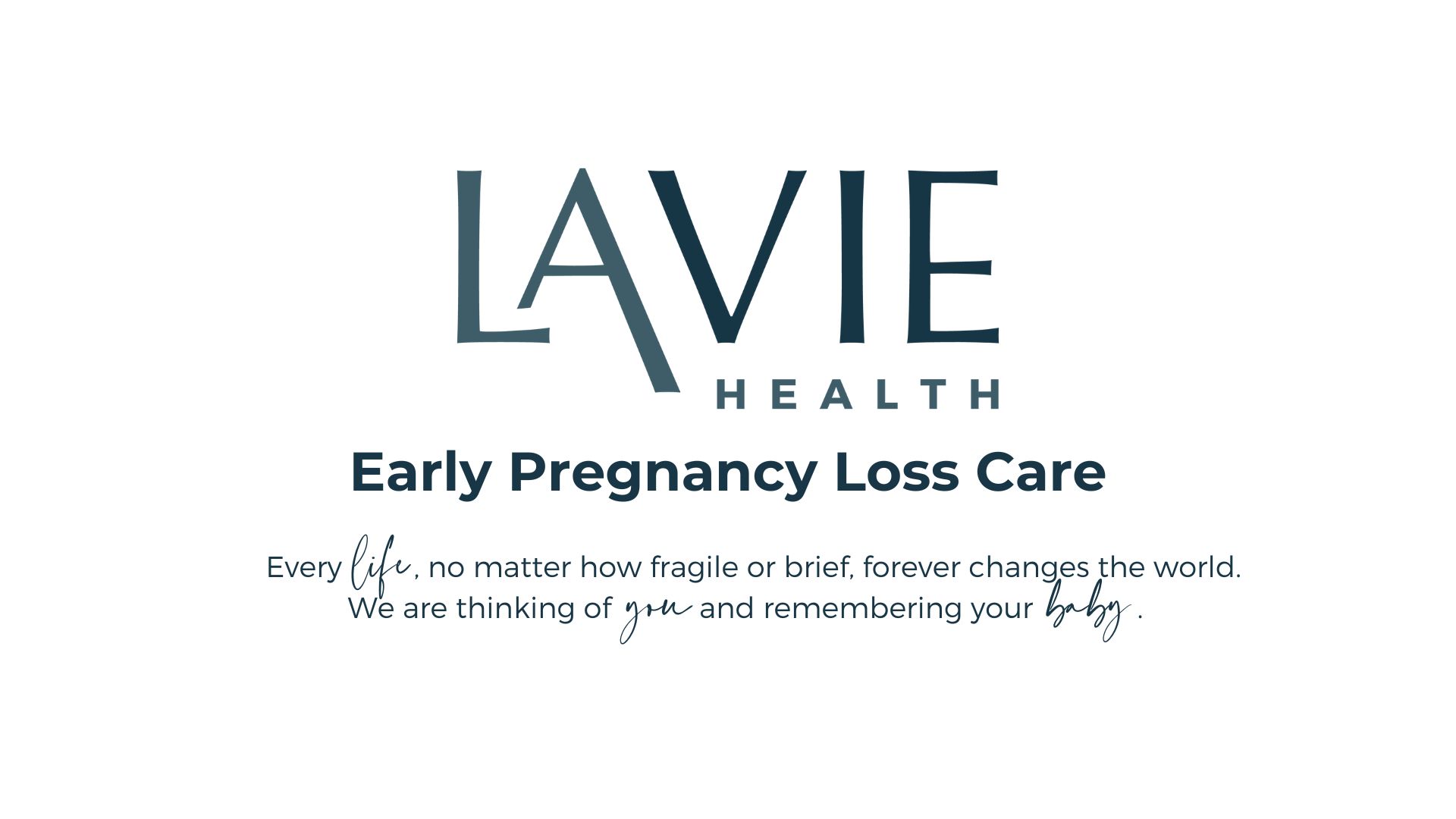At LaVie, we are aware that early pregnancy loss ends the life of an unborn child, and there is a legitimate need to grieve. We have put together a few questions and answers to help you care for yourself following an early pregnancy loss. Our team offers emotional support, information, and encouragement to those who have experienced early pregnancy loss. Please call LaVie at 406-652-4868 for more information.
What does a miscarriage feel like?
A miscarriage usually starts with vaginal bleeding. This could range from light spotting to heavy bleeding. In most miscarriages, you will also experience lower abdominal pain, which may feel like period pain, severe cramps, or even as severe as contractions. As a miscarriage progresses, you may also pass fluid and blood clots from your vagina.
It is normal to feel very upset if you think you are having a miscarriage. Everyone responds differently and it can take a while to process what is happening. We recommend seeking support from your partner, family or a close friend if you are experiencing early pregnancy loss. Having a support system is valuable.
What happens during a miscarriage?
Unfortunately, nothing can be done to stop a miscarriage once it has started. Any treatment given is to reduce the chance of heavy bleeding or infection. During a miscarriage, your body will pass your baby and other pregnancy tissue, including a pregnancy sac and placenta.
How long the physical miscarriage process takes depends on how you and your provider decide to manage the miscarriage. Options include:
-
- a ‘wait and see’ approach (expectant management)
- taking medication to help your body pass the baby and other pregnancy tissue (medical management)
- a surgical procedure to remove the baby and other pregnancy tissue from your uterus (surgical management).
Expectant Management
Expectant management is when you wait to see what will happen naturally. When your miscarriage starts, you will notice spotting and cramping and then start bleeding more heavily. The cramps will usually become stronger as you pass the baby. If you read below, you will find more accurate information about what you may experience based on your gestation.
The process may take up to 2 weeks to start from when the baby dies. Some amount of bleeding can continue for up to 2 weeks after you pass the baby and other pregnancy tissue.
It can be emotionally difficult to wait for the miscarriage to begin because you don’t know when it will happen.
Medical Management
Some people choose to have medical management because they don’t want to wait for up to 2 weeks for their baby and other pregnancy tissue to pass naturally. Your doctor can prescribe medication, so the physical experience is sped up. The medication may cause you to have pain and bleeding like what you would experience naturally in a miscarriage, or it could increase your pain. The baby and other pregnancy tissue are likely to pass within 4 to 6 hours; however, sometimes, you will need more doses of medication.
Surgical Management
If your baby or other pregnancy tissue remains in your uterus, or you don’t want to experience the pain or bleeding of miscarriage, you may choose to have a surgical procedure called a ‘dilatation and curettage‘ (D&C). You may need to wait some time for your surgery. The procedure only takes 5 to 10 minutes under anesthesia, and you will usually be able to go home the same day.
What are some practical tools to help me manage my miscarriage at home?
- Rest
- Maxi pads or disposable underwear
- Over-the-counter pain relievers such as Acetaminophen (Tylenol)or other homeopathic remedies for pain or cramping
- Heating Pad
- A support person
- Practical items to help you preserve your baby: strainer or toilet specimen hat to place over the toilet, disposable gloves, and a container for baby.
While you are waiting for a miscarriage to finish, it’s best to rest at home and do what feels right for you. If you are bleeding, use sanitary pads rather than tampons to reduce the chance of infection.
If you have heavy vaginal bleeding (soaking more than 2 maxi pads per hour for 2 consecutive hours, passing clots larger than golf ball size, fever, chills, or intense pain, call your provider or go immediately to the nearest emergency department for evaluation and treatment.
What does a miscarriage look like?
In the first month of pregnancy, the developing baby is the size of a grain of rice so it is very hard to see. You may pass a blood clot or several clots from your vagina, and there may be some white or grey tissue in the clots. The bleeding will settle down in a few days, although it can take up to 2 weeks.
At 6 weeks
Most women can’t see anything recognizable when they have a miscarriage at this time. During the bleeding, you may see clots with a small fluid-filled sac. The baby, which is about the size of the fingernail on your little finger, and a placenta might be seen inside the sac. You might also notice something that looks like an umbilical cord.
At 8 weeks
The tissue you pass may look dark red and shiny — some women describe it as looking like liver. You might find a sac with an baby inside, about the size of a small bean. If you look closely, you might be able to see where the eyes, arms and legs were forming.
At 10 weeks
The clots that are passed are dark red and look like jelly. They might have what looks like a membrane inside, which is part of the placenta. The sac will be inside one of the clots. At this time, the developing baby is usually fully formed but still tiny and difficult to see.
At 12 to 16 weeks
If you miscarry now, you might notice water(amniotic fluid) coming out of your vagina first, followed by some bleeding and clots. The fetus will be tiny and fully formed. If you see the baby it might be outside the sac by now. It might also be attached to the umbilical cord and the placenta.
From 16 to 20 weeks
This is often called a ‘late miscarriage’. You might pass large shiny red clots that look like liver as well as other pieces of tissue that look and feel like membrane. It might be painful and feel just like labor, and you might need pain relief in the hospital. Your baby will be fully formed and can fit in the palm of your hand.
What happens after a miscarriage?
After a miscarriage, you will have some cramping pain and bleeding, similar to a period. It will get lighter over time and will usually stop within 2 weeks.
Don’t put anything inside your vagina for at least 2 weeks after a miscarriage. This includes tampons, menstrual cups, sexual intercourse, and fingers or sex toys. Schedule a follow-up appointment with your provider to discuss your recovery.
Signs of pregnancy, such as nausea and tender breasts, usually fade in the days after the miscarriage. If you had a late miscarriage, your breasts might produce some milk. You will usually have your next period in 4 to 6 weeks.
Remember, it is normal to feel many different emotions at this time, and support is available.
Resources and Support
Grief Support:
-
- Aspen’s Angels Grief Recovery | 71 25th St W Suite #12 | (406) 661-3473
aspensangels.life
- Aspen’s Angels Grief Recovery | 71 25th St W Suite #12 | (406) 661-3473
-
- Compassionate Friends | tcfbillings.org
-
- Grief Share | griefshare.org
Visit griefshare.org for local support group information
- Grief Share | griefshare.org
-
- Rainbow | rainbowbereavementsupport.org | (406) 248-3487
pregnancy and infant loss parent-to-parents support group
- Rainbow | rainbowbereavementsupport.org | (406) 248-3487
-
- Walla Walla University Billings Mental Health Clinic | 2520 5th Ave. South | (406) 254-0308 free counseling
-
- Virginia Power Biblical Counseling | 2501 4th Ave N | virginiapower@gmail.com | free to low-cost biblical counseling
Ideas Of Ways To Honor and Celebrate Your Baby:
There is no wrong or right way to honor your baby. Grief is not linear, and healing can take time. Every life, no matter how fragile or brief, forever changes the world. We are thinking of you and remembering your baby. We hope these ideas will help you find a way to celebrate the life of your sweet baby.
Here are some ways you can honor your baby:
-
- Name your baby.
- If you don’t know a gender, many parents choose a gender-neutral name or pick a name based on a gut feeling, or even a nickname.
- Purchase a Memory Brick at Rose Park. (tcfbillings.org)
- Pick out a Christmas ornament.
- Buy birthstone or birth month flower jewelry (Etsy)
- Order memorial art (Etsy)
- Plant a tree or flower garden.
- Consider creating a tradition of remembrance on significant dates like lighting a candle, having a birthday cake, picking out a birthday card, or something uniquely special to your family.
- Name your baby.
Here are a few organizations with resources supporting you and ways to honor your baby. This is not a complete list; many small businesses and artists create beautiful items to help honor your baby.
-
- Evermore Blooms | evermoreblooms.org
- Hope Again Collective | hopeagaincollective.com
- Held In Hope | heldinhope.org
- Miscarriage Hurts | miscarriagehurts.com
- Sage & Sara | sageandsaracandles.com






